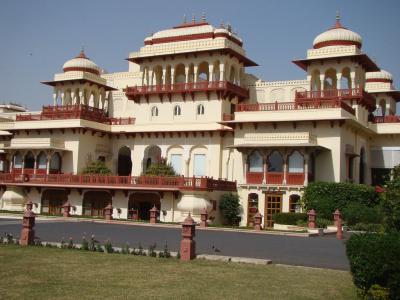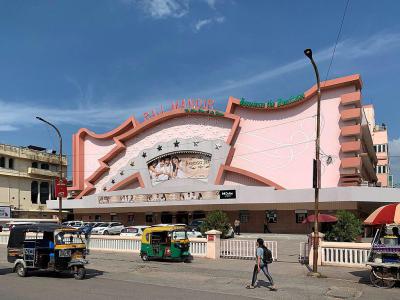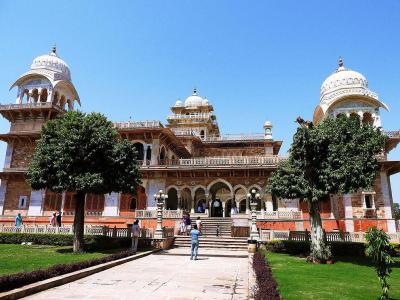
Jaipur Landmarks Walking Tour (Self Guided), Jaipur
Jaipur is also known as the Pink City because of the many pink sandstone buildings around. These beautiful buildings help make Jaipur one of India’s most impressive places. There are plenty of other great landmarks around the city that you can see using our Landmarks Walking Tour.
How it works: Download the app "GPSmyCity: Walks in 1K+ Cities" from Apple App Store or Google Play Store to your mobile phone or tablet. The app turns your mobile device into a personal tour guide and its built-in GPS navigation functions guide you from one tour stop to next. The app works offline, so no data plan is needed when traveling abroad.
Jaipur Landmarks Walking Tour Map
Guide Name: Jaipur Landmarks Walking Tour
Guide Location: India » Jaipur (See other walking tours in Jaipur)
Guide Type: Self-guided Walking Tour (Sightseeing)
# of Attractions: 8
Tour Duration: 4 Hour(s)
Travel Distance: 10.0 Km or 6.2 Miles
Author: vickyc
Sight(s) Featured in This Guide:
Guide Location: India » Jaipur (See other walking tours in Jaipur)
Guide Type: Self-guided Walking Tour (Sightseeing)
# of Attractions: 8
Tour Duration: 4 Hour(s)
Travel Distance: 10.0 Km or 6.2 Miles
Author: vickyc
Sight(s) Featured in This Guide:
- Birla Mandir Temple
- Rambagh Palace
- Birla Planetarium
- Raj Mandir Cinema
- Albert Hall Museum
- Hawa Mahal Museum
- Jantar Mantar
- Jorawar Singh Gate
1) Birla Mandir Temple (must see)
The Birla Mandir Temple is a sacred place for Hindus. Also known as the Laxmi Narayan Temple, it is dedicated to Lord Laxmi Narayan. This contemporary temple attracts many visitors, especially at night when its white marble exterior is magnificently illuminated. Look closer to see scenes from Hindu mythology painted on the windows, as well as marble idols and sculptures.
2) Rambagh Palace
The Rambagh Palace is the former residence of the Maharaja of Jaipur and now a luxury Taj Palace Hotel, located 5 miles (8.0 km) outside of the walls of the city of Jaipur on Bhawani Singh Road. Preferred by celebrities and sport stars across the globe, Rambagh Palace, is widely considered to be one of the best hotels around the world.
The first building on the site was a garden house built in 1835 for the wet nurse of prince Ram Singh II. In 1887, during the reign of Maharaja Sawai Madho Singh, it was converted into a modest royal hunting lodge, as the house was located in the midst of a thick forest at that time. In the early 20th century, it was expanded into a palace. Maharajah Sawai Man Singh II made Rambagh his principal residence and added a number of royal suites in 1931.
After India became independent and the princely states united, the Palace became the Government House. By the 1950s, the royal family felt that the upkeep of the palace and its 47 acres (190,000 square meters) of gardens was becoming very costly. They, therefore, decided in 1957 to convert it into a luxury hotel.
The first building on the site was a garden house built in 1835 for the wet nurse of prince Ram Singh II. In 1887, during the reign of Maharaja Sawai Madho Singh, it was converted into a modest royal hunting lodge, as the house was located in the midst of a thick forest at that time. In the early 20th century, it was expanded into a palace. Maharajah Sawai Man Singh II made Rambagh his principal residence and added a number of royal suites in 1931.
After India became independent and the princely states united, the Palace became the Government House. By the 1950s, the royal family felt that the upkeep of the palace and its 47 acres (190,000 square meters) of gardens was becoming very costly. They, therefore, decided in 1957 to convert it into a luxury hotel.
Sight description based on Wikipedia.
3) Birla Planetarium
Set within the Birla Science & Technology Center, the Birla Planetarium is one of the most prominent landmarks in Jaipur. This modern, fully equipped facility has amazing audio-visual displays that show visitors the mysteries of cosmos in an amazing and creative way.
4) Raj Mandir Cinema (must see)
Raj Mandir Cinema is a famous movie theater in Jaipur. Situated on the Bhagwan Das Road, the meringue-shaped auditorium opened in 1976, and over the years has seen many movie premieres of Hindi films, and has become a popular symbol of Jaipur, it is often referred as the Pride of Asia. It opened on 1 June 1976 with the film "Bazigar".Cinema was designed by architect W.M. Namjoshi in Art Moderne style (Streamline Moderne or late Art Deco). Known for its large size as well as opulent and meringue interiors, Raj Mandir remains an important part of the tourist circuit, and thus usually remains full despite its size.
Sight description based on Wikipedia.
5) Albert Hall Museum (must see)
Albert Hall Museum is the oldest museum of the state and functions as the State museum of Rajasthan. The building is situated in Ram Niwas Garden outside the city wall opposite New gate and is a fine example of Indo-Saracenic architecture. The building was designed by Sir Samuel Swinton Jacob and was opened as public museum in 1887. It is also called the Government Central Museum.
Maharaja Ram Singh initially wanted this building to be a town hall, but his successor, Madho Singh II, decided it should be a museum for the art of Jaipur and included as part of the new Ram Nivas Garden. The museum has a rich collection of artefacts like paintings, carpets, ivory, stone, metal sculptures, colourful crystal works etc. It is named after King Edward VII (Albert Edward), during whose visit to the city as the Prince of Wales, its foundation stone was laid on February 6, 1876.
Maharaja Ram Singh initially wanted this building to be a town hall, but his successor, Madho Singh II, decided it should be a museum for the art of Jaipur and included as part of the new Ram Nivas Garden. The museum has a rich collection of artefacts like paintings, carpets, ivory, stone, metal sculptures, colourful crystal works etc. It is named after King Edward VII (Albert Edward), during whose visit to the city as the Prince of Wales, its foundation stone was laid on February 6, 1876.
Sight description based on Wikipedia.
6) Hawa Mahal Museum (must see)
Hawa Mahal ("Palace of Winds" or “Palace of the Breeze”) was built in 1799 by Maharaja Sawai Pratap Singh, and designed by Lal Chand Ustad in the form of the crown of Krishna, the Hindu god. Its unique five-storey exterior is also akin to the honeycomb of the beehive with its 953 small windows called jharokhas that are decorated with intricate latticework. The original intention of the lattice was to allow royal ladies to observe everyday life in the street below without being seen, since they had to observe strict "purdah" (face cover).
Built of red and pink sandstone, the palace is situated on the main thoroughfare in the heart of Jaipur’s business centre. It forms part of the City Palace, and extends to the Zenana or women' chambers, the chambers of the harem. It is particularly striking when viewed early in the morning, lit with the golden light of sunrise.
Built of red and pink sandstone, the palace is situated on the main thoroughfare in the heart of Jaipur’s business centre. It forms part of the City Palace, and extends to the Zenana or women' chambers, the chambers of the harem. It is particularly striking when viewed early in the morning, lit with the golden light of sunrise.
Sight description based on Wikipedia.
7) Jantar Mantar (must see)
The Jantar Mantar is a collection of architectural astronomical instruments, built by Maharaja (King) Jai Singh II at his then new capital of Jaipur between 1727 and 1734. It is modeled after the one that he had built for him at the Mughal capital of Delhi. He had constructed a total of five such facilities at different locations, including the ones at Delhi and Jaipur. The Jaipur observatory is the largest and best preserved of these. It has been inscribed on the World Heritage List as "an expression of the astronomical skills and cosmological concepts of the court of a scholarly prince at the end of the Mughal period".
The observatory consists of fourteen major geometric devices for measuring time, predicting eclipses, tracking stars' location as the earth orbits around the sun, ascertaining the declinations of planets, and determining the celestial altitudes and related ephemerides. Each is a fixed and 'focused' tool. The Samrat Yantra, the largest instrument, is 90 feet (27 m) high, its shadow carefully plotted to tell the time of day.
The observatory consists of fourteen major geometric devices for measuring time, predicting eclipses, tracking stars' location as the earth orbits around the sun, ascertaining the declinations of planets, and determining the celestial altitudes and related ephemerides. Each is a fixed and 'focused' tool. The Samrat Yantra, the largest instrument, is 90 feet (27 m) high, its shadow carefully plotted to tell the time of day.
Sight description based on Wikipedia.
8) Jorawar Singh Gate
Jaipur is also known as the Pink City because of its many attractive rose-colored buildings. One of these pretty sights is the Jorawar Singh Gate, which is also a great example of Indian architecture. Named after a general, this gate is the entryway to the northern area of the city, acting as a beautiful introduction to a walk around this part of town.
The Most Popular Cities
/ view all







